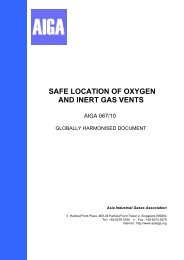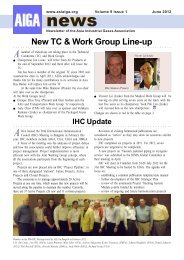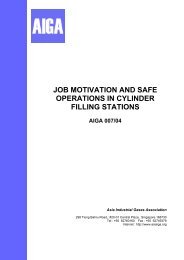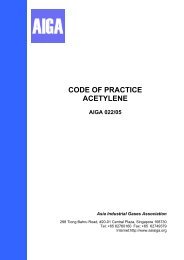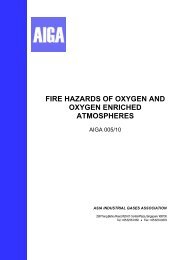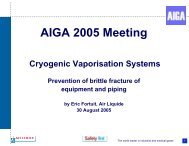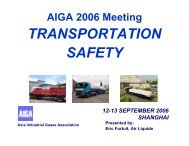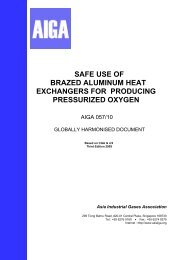CLEANING OF EQUIPMENT FOR OXYGEN SERVICE - AIGA
CLEANING OF EQUIPMENT FOR OXYGEN SERVICE - AIGA
CLEANING OF EQUIPMENT FOR OXYGEN SERVICE - AIGA
You also want an ePaper? Increase the reach of your titles
YUMPU automatically turns print PDFs into web optimized ePapers that Google loves.
18<br />
<strong>AIGA</strong> 012/04<br />
These characteristics of flammability are well known and the use of flammable products for oxygen<br />
cleaning is strongly limited. However if this type of product is used, the procedure for rinsing, purging<br />
and checking has to be carefully qualified.<br />
It shall be ensured that after the complete procedure no residuals of flammable vapour or liquid<br />
remain in the equipment especially in complicated configurations, dead ends etc.<br />
The qualified procedure is specific for a given equipment.<br />
When non-flammable solvents are chosen, hydrocarbon-free grades should be used.<br />
The recycling of solvents and their ultimate safe disposal must conform to national legislative<br />
requirements. Accurate records should be maintained with a view to establishing a mass balance.<br />
Where disposal of spent solvent is required, it will normally be necessary to employ an approved<br />
professional waste disposal agent.<br />
National legislation will normally stipulate the storage and transport requirements. All solvent,<br />
recovered solvent and waste must be clearly labelled. Solvent must never be discharged directly into<br />
drains, sewers or natural watercourses. Checks should be carried out on the purity of solvent that is<br />
reused or has been recovered.<br />
5.2.4 Water Based Detergents<br />
Detergent cleaning is done in water solutions containing chemicals with different functions. It is<br />
normally performed in an alkaline environment, the higher pH value, the better the degreasing<br />
efficiency<br />
Common components in alkaline detergents and their main functions are shown in table 4.<br />
The most important detergent components are the surfactants. They decrease the surface tension of<br />
the water solution, penetrate the organic contaminants and make them disperse as small droplets into<br />
the water solution.<br />
Proprietary synthetic detergents are available for use to clean different polymers, metals and alloys. It<br />
is most important the manufacturer's recommendations are complied with and also the effect on any<br />
non-metallic materials which are present.<br />
5.2.5 Emulsion Cleaners<br />
Emulsion cleaner systems have three main components - water, an organic solvent and surfactants.<br />
They are used in two ways:<br />
- The solvent emulsified in water is applied in a manner similar to standard aqueous cleaners. The<br />
solvent is the main dirt dissolver and the surfactants work principally as emulsifiers.<br />
- Water-free solvents with added emulsifiers are applied in concentrated form and then rinsed with<br />
water. The emulsifying of the solvent and cleaning products takes place first when water is added<br />
in the subsequent rinsing stage.<br />
For safety and environmental reasons, solvents with high flash point and low vapour pressure are<br />
normally chosen. Examples of solvents are different high) oiling hydrocarbons, citrus based terpenes.<br />
(e.g. d-limonene) and pine based terpenes. Other examples are esters (e.g. lactate esters) and glycol<br />
ethers.<br />
Proprietary emulsion cleaners are available to clean different polymers, metals and alloys. It is most<br />
important the manufacturers recommendations are complied with and also the effect on any<br />
non-metallic materials which are present.



